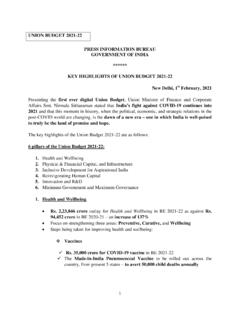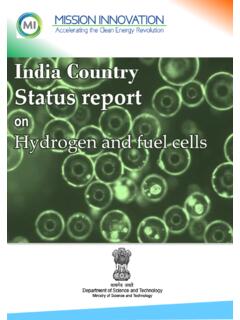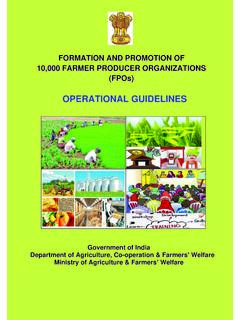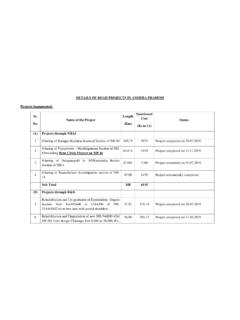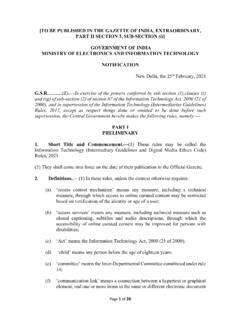Transcription of National Action Plan on Climate Change (NAPCC)
1 RU-49-03-0004-011221/FAQ ( frequently asked Questions (FAQs) National Action Plan on Climate Change (NAPCC) (Ministry of Environment, Forest and Climate Change ) December 01, 2021 Context Climate change1 is one of the most critical global challenges of our times. Recent events have emphatically demonstrated our growing vulnerability to Climate Change . Climate Change impacts will range from affecting agriculture further endangering food security to sea-level rise and the accelerated erosion of coastal zones, increasing intensity of natural disasters, species extinction, and the spread of vector-borne diseases. Introduction The vulnerability assessment and adaptation studies of Climate Change were made in various areas such as water resources, agriculture, forests, natural eco-systems, coastal zones, health energy and infrastructure as a part of the Initial National Communication of India2 to the United Nations Framework Convention on Climate Change (UNFCCC).)
2 Further, the Expert Committee on Impact of Climate Change set up by the Ministry of Environment & Forests in June 2007 assessed the impact of Climate Change on six areas, namely water resources, agriculture, Natural Ecosystem, Health, Coastal Zone Management and Climate modelling. Reports of the Expert Committee were then prepared and a range of policies and programmes were initiated to address the problem of Climate Change in the context of sustainable development. 1. What is the National Action Plan on Climate Change (NAPCC)? The National Action Plan on Climate Change (NAPCC) was released by the Prime Minister on 30th June It outlines a National strategy that aims to enable the country to adapt to Climate Change and enhance the ecological sustainability of India s development path.
3 It stresses that maintaining a high growth rate is essential for increasing living standards of the vast majority of people of India and reducing their vulnerability to the impacts of Climate Change . There are eight National Missions which form the core of the National Action Plan. They focus on promoting understanding of Climate Change , adaptation and mitigation, energy efficiency and natural resource conservation. 4 1 2 3 4 2. What are the missions that come under the National Action Plan for Climate Change ? There are eight National Missions5 on Climate Change : 1. National Solar Mission 2. National Mission for Enhanced Energy Efficiency 3. National Mission on Sustainable Habitat 4. National Water Mission 5. National Mission for Sustaining the Himalayan Eco-system 6.
4 National Mission for a Green India 7. National Mission for Sustainable Agriculture 8. National Mission on Strategic Knowledge for Climate Change 3. What are the principles of this plan? The Principles of NAPCC6 are: Protecting the poor through an inclusive and sustainable development strategy, sensitive to Climate Change Achieving National growth and poverty alleviation objectives while ensuring ecological sustainability Efficient and cost-effective strategies for end-use demand-side management Extensive and accelerated deployment of appropriate technologies for adaptation and mitigation New and innovative market, regulatory, and voluntary mechanisms for sustainable development Effective implementation through unique linkages with civil society, LGUs, and public-private partnerships 4.
5 What is the National Solar Mission (NSM)? The NSM was launched in January 20107, with the objective of establishing India as a global leader in solar energy, by creating the policy conditions for solar technology diffusion across the country as quickly as possible. The initial target of NSM was to install 20 GW solar power by 2022. This was upscaled to 100 GW in early 2015. Numerous facilitative programmes and schemes under the Mission have driven the grid connected solar power installed capacity from 25 MW in the year 2010-11 to about GW as on 31st October 2020. An additional GW solar power capacity is currently under installation/ tendering process. 5 6 7 is the objective of the National Solar Mission?
6 The objective of the National Solar Mission8 is to establish India as a global leader in solar energy, by creating the policy conditions for its diffusion across the country as quickly as possible. The Mission adopts a three-phase approach, Phase 1 (up to 2012 - 13), Phase 2 (2013 - 17) and Phase 3 (2017 - 22). The immediate aim of the Mission is to focus on setting up an enabling environment for solar technology penetration in the country both at a centralized and decentralized level. 6. What is the National Mission for Enhanced Energy Efficiency (NMEEE)? NMEEE aims to strengthen the market for energy efficiency by creating conducive regulatory and policy regime and has envisaged fostering innovative and sustainable business models to the energy efficiency sector. The Mission is implemented since NMEEE consists of four initiatives to enhance energy efficiency in energy intensive industries10: Perform, Achieve and Trade (PAT) Market Transformation for Energy Efficiency (MTEE) Energy Efficiency Financing Platform (EEFP) Framework for Energy Efficient Economic Development (FEEED) 7.
7 What is the National Mission on Sustainable Habitat? The National Mission on Sustainable Habitat was approved by the Prime Minister s Council for Climate Change in June The key deliverables of the Mission include: Development of sustainable habitat standards that lead to robust development strategies while simultaneously addressing Climate Change related concerns Preparation of city development plans that comprehensively address adaptation and mitigation concerns Preparation of comprehensive mobility plans that enable cities to undertake long-term, energy efficient and cost effective transport planning Capacity building for undertaking activities relevant to the Mission 8. Whatis the National Water Mission? A National Water Mission12 will ensure integrated water resource management helping to conserve water, minimize wastage and ensure more equitable distribution both across and within states.
8 The Mission will take into account the provisions of the National Water Policy and develop a framework to optimize water use by increasing water use efficiency by 20 per cent through regulatory mechanisms with differential 8 Jawaharlal Nehru National Solar Mission Vikaspedia 9 10 11 12 entitlements and pricing. It will seek to ensure that a considerable share of the water needs of urban areas are met through recycling of waste water, and ensuring that the water requirements of coastal cities with inadequate alternative sources of water are met through adoption of new and appropriate technologies such as low temperature desalination technologies that allow for the use of ocean water. NWM13has identified five goals which are mentioned below: Comprehensive water data base in public domain and assessment of the impact of Climate Change on water resource Promotion of citizen and state actions for water conservation, augmentation and preservation Focused attention to vulnerable areas including over-exploited areas Increasing water use efficiency by 20 per cent Promotion of basin level integrated water resources management 9.
9 What is the National Mission for sustaining the Himalayan Eco-system? This particular mission sets the goal to prevent melting of the Himalayan glaciers and to protect biodiversity in the Himalayan The Himalayan ecosystem as a National mission will focus on the rapid generation of four types of National capacities, which deal with: Human and knowledge capacities Institutional capacities Capacities for evidence based policy building and governance Continuous self-learning for balancing between forces of Nature and actions of mankind The mission attempts to address some important issues concerning Himalayan Glaciers and the associated hydrological consequences Biodiversity conservation and protection Wildlife conservation and protection Traditional knowledge societies and their livelihood and Planning for sustaining the Himalayan Ecosystem 10.
10 What is the National Mission for a Green India? The Cabinet Committee on Economic Affairs approved a proposal of the Ministry of Environment and Forests for a National Mission for a Green India15(GIM) as a Centrally Sponsored Scheme. GIM puts greening 16 in the context of Climate Change adaptation and mitigation. Greening is meant to enhance ecosystem services such as carbon sequestration and storage (in forests and other ecosystems), hydrological services and biodiversity; as well as other provisioning services such as fuel, fodder, small timber and non- timber forest products (NTFPs). The Mission aims at responding to Climate Change by a combination of adaptation and mitigation measures, which would help: 13 14 15 16 Enhancing carbon sinks in sustainably managed forests and other ecosystems Adaptation of vulnerable species/ecosystems to the changing Climate Adaptation of forest-dependent communities The objectives of the Mission are.

